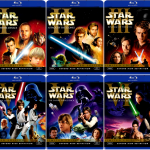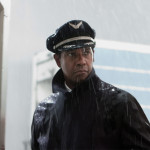Archives For Film
Have you noticed how the second Star Wars trilogy (episodes I-III) parallels the first (episodes IV-VI)? Here are a few examples.
A New Hope (IV) and the Phantom Menace (I)
- Both Luke and Anakin Skywalker leave their family on Tatooine to be trained by Obi-wan as a Jedi.
- Obi-wan is killed by a Sith lord in front of his apprentice Luke just as Qui Gon is killed by a Sith lord in front of his apprentice Obi-wan
- Both films climax with Skywalkers (Luke and Anakin) in a space battle in which they blow up the enemy space-station
- Full cast appears in triumphant award ceremony
The Empire Strikes Back (V) and Attack of the Clones (II)
- Male leads are separated during “romantic” chapter of the film.
- Both Boba and Jango Fett follow heros in Slave I through astroid field while heros hide behind an asteroid and escape with the garbage.
- The first begins with a battle against giant robot walkers and the later ends with battle against giant robot walkers
- C-3PO is dismantled in a droid factory
- Both Luke and Anakin Skywalker lose an appendage and get a robotic replacement.
Return of the Jedi (VI) and Revenge of the Sith (III)
- The original title of Return of the Jedi was Revege of the Jedi
- The Emperor makes his first real appearance both these films
- Both Luke and Anakin Skywalker wear a black glove to cover their robotic hands.
- Luke battles Vader while Palpatine watches just as Anakin battles Dooku while Palpatine watches
- Luke cuts off Vader’s robotic hand in light saber duel just as Obi wan cuts off Grevous’ robotic hand in the same way
- Ewoks battle from tree homes on Endor just as Wookies battle from tree homes on Kashyyk
- Vader unmasked in the former while Vader is masked in the later
- Ends with funeral
The list of parallels goes on. You can find a more complete list here webpage. It’s pretty clear that the two Star Wars trilogies were arranged in a parallel a-b-c-a’-b’-c’ pattern.
Parallel Patterns in the Old Testament
I bring this up because I think it’s interesting that at least some people still recognize and value such implicit parallels. For the ancient writer and reader it was no different. These parallels in Star Wars are great illustration of the way the biblical writers structured some of their writings. Here’s what David Dorsey says in his extremely helpful book the Literary Structure of the Old Testament.
Parallel arrangements are relatively common in the Hebrew Bible. They generally feature two sets (or panels) of units, in which the units of the first set are matched in the same order by those of the first set (a-b-c II a’-b’-c’ or variations). When a parallel scheme has an odd number of units, the unmatched unit can be placed at the end (a-b-c II a’-b’-c’ II d), center (a-b-c-d-a’-b’-c’), or (more rarely) beginning (a-b-c-d II b’-c’-d’).
Parallelism frequently occurs in Hebrew poetry. Note for example, the a-b-c II a’-b’-c’ pattern in Psalm 19:1-2 {19:2-3}:
a the heavens
b tell of
c God’s glory
a’ the sky
b’ proclaims
c’ his handiwork
a day by day
b they pour forth
c speech
a’ night by night
b’ they declare
c’ knowledge
The pattern can also be found in larger unites. For example, the creation story in Genesis 1:1-2:4, although primarily linear (first day, second day, etc.), exhibits a secondary parallel pattern (a-b-c II a’-c’c’ II d):
a light
b sea and sky
c dry land
a’ lights
b’ fish and birds
c’ land animals and humans
d Sabbath
Whole books may likewise be arranged in this way. The seven parts of Jonah are primarily linear in arrangement (following a chronological order), but also exhibit a secondary parallel pattern (a-b-c II a’-b’-c’ II d):
a Jonah’s commissioning and disobedience (1:1-3)
b Jonah and pagan sailors: Yahweh is merciful (1:4-16)
c Jonah’s response to Yahweh’s mercy: praise (1:17-2:10 {2:1-11})
a’ Jonah’s recommissioning and obedience (3:1-3a)
b’ Jonah and pagan Ninevites: Yahweh is merciful (3:3b-10)
c’ Jonah’s response to Yahweh’s mercy: resentment (4:1-4)
d Yahweh’s lesson (4:5-11)
Parallel Patterns in the New Testament
But its not just in the Old Testament. I’m fascinated by the way the Gospel writers conveyed meaning through the arrangement of there parts. Here’s one very significant example.
We all know that Luke begins his story with two annunciation scenes. But did you know that Luke uses parallels to arrange them in a meaningful structure. Look at this:
a Description of Zacharias and his situation (1:5-10)
b Angel’s message to Zacharias (1:11-22)
c Zacharias returns home and Elizabeth reacts to the news (1:23-25)
a’ Description of Mary and her situation (1:26-27)
b’ The Angel’s message to Mary (1:28-38)
c’ Mary goes to Zacharias’ home and Elizabeth reacts to the news (1:39-
d Mary’s sings a song
When we miss the pattern we miss some of the message that Luke’s attempting to convey. And the same goes for other patterns in the New Testament. For more on how Luke uses this parallel pattern to convey meaning check out these two posts: What Happens When You’re Filled with the Spirit and Why God Shut Zachariah’s Mouth.
If you’re looking for a film to watch with a nonchristian friend this Easter you don’t have turn to an adaptation of Gospels to catch a glimpse of Jesus. Christ figures are literally everywhere on the silver screen.
Unlike the figure of Jesus portrayed in a gospel film, a Christ figure is any character who parallels the life, death or resurrection of Jesus. Depending on the similarities, the reference may be painfully obscure or glowingly transparent.
John Coffey, for instance, in the Green Mile is most certainly a Christ figure. Did you catch that his initials are J.C! And if that doesn’t convince you, he also heals, raises the dead and is executed by the state for a crime he didn’t commit.
But Christ figures also play central roles in films like
- Les Miserables
- Shane
- Superman
- Cool Hand Luke
- One Flew Over the Cuckoo’s Nest
- Aliens 3
- V for Vendetta
- Sling Blade
- Gladiator.
And that’s just a few.
My goal here though isn’t just to point you to films that make an implicit reference to Jesus. For that we would need a little more time. Instead I want to narrow the focus to films that also allude to His resurrection.
Here’s a list of ten, plus an extra thrown in for good measure.
- The Day the Earth Stood Still (1951)
- E. T. (1982)
- The Shawshank Redemption (1994)
- Braveheart (1995)
- The Truman Show (1998)
- The Iron Giant (1999)
- The Matrix (1999)
- Lord of the Rings: The Two Towers (2003)
- The Lion, the Witch and the Wardrobe (2005)
- Thor (2011)
- Harry Potter and the Deathly Hallows: Part 2 (2011)
What do you think? Which of these films most suprised you? Are there films you believe have been missed?
And by the way half of these films found their way into a short video I put together called the Longing of Man. Check it out! I think you’ll enjoy it.
Sometimes a beginning foreshadows the story.
The hair-raising opening to the 2012 movie Flight, for instance, encapsulates the rest of the film.
When a sudden malfunction sends his plane into a nosedive, Captain Whip Whitfield though heavily intoxicated and high on cocaine manages to crash-land in an open field.
Beginning: The initial malfunction or what the film later refers to as an “act of God” represents the crash of the plane which will send Whip’s personal life in like manner spiraling out of control.
Middle: His impaired efforts to recover the plane stands for his subsequent attempts to hide his alcohol and drug use from authorities while personally losing himself to his addictions.
End: And finally the plane crash with minimal loss of life foreshadows the joy and the tragedy in the film’s ultimate conclusion. (I’m not going to spoil it for you.)
The Bible
Such beginnings were not unknown or unused by Biblical writers.
Luke, for instance in his nativity (Luke 1), juxtaposes the accounts of Zachariah and Mary to stress the important contrast that will unfold throughout his story.
Like Zachariah, rich, powerful, male, Jews by and large reject God’s message while the poor, the powerless, women, and Gentiles, represented in Mary, receive it. As a result the voices of the powerful are taken from them while the dispossessed begin to sing.
But the whole Bible, though made up of various authors, is likewise is fittingly foreshadowed in its opening scenes.
In the Beginning God creates Man (male and female), gives them a law and a land but Man disobeys the law and is ejected from the land.
Sound familiar? It should. It’s the story of Israel.
Genesis 1-3 is not just a history lesson about origins. It’s a summary which directs our attention to the Bibles main theme.
Today when we read Genesis 1 it seems incredible. How could the earth have a morning and an evening before there was a sun? Why would God jump from the fish to the birds without first creating animals on land? And perhaps the biggest question, why would God who has the power to create the earth instantly take six days and then a holiday?
Such questions become less of an issue, however, when we see how the details of the account foreshadow the Bible’s larger narrative.
God is building.
What he’s building is a temple.
A temple in which He will indwell His own Idol – Man.
I love the movie Groundhog Day! And not just because it’s the first movie my wife and I ever saw together. This movie is funny as well as profound.
What would you do if you were stuck in one place and every day was exactly the same, and nothing that you did mattered?
This isn’t just the question Bill Murray as the self-obsessed Phil Connors must ask. It’s the question the filmmakers want us to ask ourselves. Who hasn’t felt like they were stuck repeating the same day over and over again?
- stuck in a mortgage that’s underwater
- stuck in an economy that won’t pay
- stuck in a job that pays too much to leave.
Stuck. Stuck. Stuck.
As Ralph replies, “That about sums it up for me.”
So what’s the films answer?
After recovering from the initial confusion of finding himself the only person reliving the same day over and over again, The narcissistic Phil Connors is eventually transformed by his unexplained set of circumstances.
Warning: Spoiler Alert
Freedom from Consequence
Phil at first finds in this repeated day the freedom to indulge himself. Immune from any lasting consequences, He does what he’s always wanted.
- He drives recklessly
- punches an annoying salesman
- stuffs himself with junk food
- smokes
- robs a bank
- manipulates a woman for sex
But what Phil Connors really wants is Rita, his coworker and producer. He spends countless days using his power to get her into bed.
But Rita won’t budge.
No amount of manipulation will make Rita go all the way.
Prison of Emptiness
Downcast by Rita’s continued rejection, Phil begins to feel the loneliness and ultimate meaninglessness of his situation. The day has become a prison. What good is an eternity without judgement when it produces no lasting results?
Phil somehow gets it into his head that he won’t be free until the groundhog ceases to see his shadow.
He steals the groundhog and leads police and town leaders on a high speed chase. Stuck between a literal rock and hard place, a quarry and a cliff, Phil drives himself off the cliff, killing himself and presumably the groundhog as well.
But death is no release for Phil. He’s resurrected the next morning to once again relive the same day.
Phil isn’t through though. He feels he must die. He
- drops a toaster in a bathtub
- steps out in front a bus.
- leaps from a church steeple
And still the day goes on.
An End to Self
At last he confesses to Rita.
“I’m a god.” He says matter-of-factly.
“You’re not God.” Rita says.
This isn’t a belief Phil’s simply derives from his unique situation. It’s the faith he’s had from well before he ever set foot in Punxsutawney.
Phil thinks he’s greater than everyone else. He thinks only of himself.
But when he gets Rita to in part “believe in him,” he’s taken back. “Maybe it really is happening. I mean how else could you know so much?” Phil replies, “there is no other way. I’m not that smart.”
Rita determines to stay with him for the day.
Later that night, the two sit on his bed tossing cards into a hat. Rita asks, “Is this what you do with eternity?” But Phil finds something more hollow in the way he spends his days.
Phil: The worst part is that tomorrow you will have forgotten all about this and you’ll treat me like a jerk again.
Rita: You’re not.
Phil: It’s all right. I am a jerk. It doesn’t make any difference. I’ve killed myself so many times, I don’t even exist anymore.
Though admitting he’s a jerk is important the final line is just as telling. We don’t typically speak of our existence rather we speak of God’s.
As the night wears on Phil reads the line “Only God can make a tree” from “Trees” by Joyce Kilmer.
Poems are made by fools like me, but only God can make a tree.
Through Rita’s friendship, Phil has begun to doubt his deity.
As she sleeps, he whispers to her his prayer of confession and repentance.
I’ve never seen anyone that’s nicer to people than you are. The first time I saw you something happened to me. I never told you, but I knew that I wanted to hold you as hard as I could. I don’t deserve someone like you. But if I ever could I swear I would love you for the rest of my life.
I don’t believe its coincidence that Rita’s name comes from both the Latin and Greek word for “pearl.” She is the “Pearl of Great Price” for which Phil must relinquish everything.
The New Man
Phil wakes up the next morning a new man. The significance of the radio’s repeated song “I’ve Got You Babe” is at last revealed. Though he once was all alone, obsessed with himself, Phil’s now has Rita. And it makes all the difference in his world.
- He gives all his cash to the homeless man he’s ignored.
- He serves his coworkers
- reads books
- Takes up piano and ice-sculpting
- greets people with a smile and a warm embrace
But there’s still a little of the old Phil that has yet to die.
Late one night he finds the homeless man shivering in a back alley. Phil takes him to the hospital where the man suddenly dies. The new Phil is upset but like the old Phil think’s he has control. Despite doing everything in his power, however, day after day, the man still dies.
As Phil performs CPR on the man one last time, we hear the man exhale and the breath leave the body. The dead man’s spirit is surrendered to God. And so is Phil. At last he looks away from himself up towards heaven.
And with that the cycle of days is broken. The last Groundhog day Phil experiences in Punxsutawney is way he was always met to experience it. Free of self.
The Answer
The fact that Phil is covering a groundhog also named Phil is clearly intentional. The Groundhog is a symbol for Phil himself.
Legend has it that if Punxsutawney Phil sees his shadow on Feb. 2, winter will last six more weeks but if doesn’t spring will come early.
I always thought it strange that the legend said the shadow indicated a continuation of winter. Perhaps its just my Washington state bias but clouds have always represented winter while sun the summer.
So why would the clouds and not sun represent the end to winter? Phil had it right. It’ not the clouds or the sun its the fixation upon the shadow. The shadow of self.
Only by looking away from ourselves to God and others will will we find true freedom and an end to the cycle of empty and meaningless days.





















